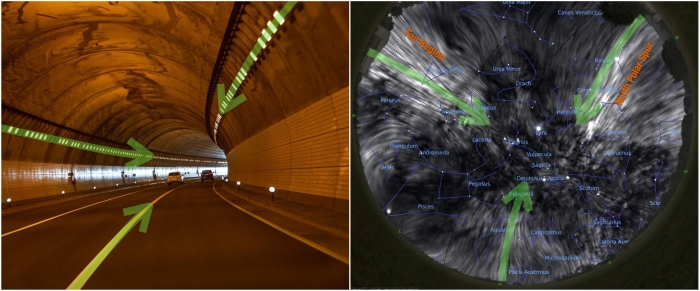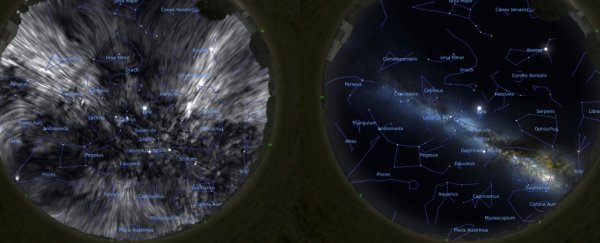Mysterious structures in the sky that have puzzled astronomers for decades might finally have an explanation – and it's quite something.
The North Polar Spur and the Fan Region, on opposite sides of the sky, may be connected by a vast system of magnetized filaments. These form a structure resembling a tunnel that circles the Solar System, and many nearby stars besides.
"If we were to look up in the sky," said astronomer Jennifer West of the University of Toronto in Canada, "we would see this tunnel-like structure in just about every direction we looked – that is, if we had eyes that could see radio light."
We've known about the two structures for quite some time – since the 1960s, in fact – but they have been difficult to understand. That's because it's really hard to work out exactly how far away they are; distances have ranged from hundreds to thousands of light-years away.
However, no analysis had ever linked the two structures together. West and her colleagues were able to show that the two regions, and prominent radio loops in the space between them, could be linked, solving many of the puzzling problems associated with both.
 Comparison with a real tunnel showing orientation. (Left: Pixabay/wal_172619/J. West; Right: Dominion Radio Astrophysical Observatory/Villa Elisa telescope/ESA/Planck Collaboration/Stellarium/J. West)
Comparison with a real tunnel showing orientation. (Left: Pixabay/wal_172619/J. West; Right: Dominion Radio Astrophysical Observatory/Villa Elisa telescope/ESA/Planck Collaboration/Stellarium/J. West)
"A few years ago, one of our co-authors, Tom Landecker, told me about a paper from 1965, from the early days of radio astronomy. Based on the crude data available at this time, the authors (Mathewson & Milne), speculated that these polarized radio signals could arise from our view of the Local Arm of the galaxy, from inside it," West explained.
"That paper inspired me to develop this idea and tie my model to the vastly better data that our telescopes give us today."
Using modelling and simulations, the researchers figured out what the radio sky would look like, if the two structures were connected by magnetic filaments, playing with parameters such as distance to determine the best fit.
From this, the team was able to determine that the most likely distance for the structures from the Solar System is around 350 light-years, consistent with some of the closer estimates. This includes an estimate for the distance of the North Polar Spur earlier this year based on Gaia data, which found that almost all of the spur is within 500 light-years.
The entire length of the tunnel modelled by West and her team is around 1,000 light-years.
 Light intensity of the North Polar Spur (top) and Fan Region (bottom). (West et al., arXiv, 2021)
Light intensity of the North Polar Spur (top) and Fan Region (bottom). (West et al., arXiv, 2021)
This model is in agreement with a wide range of observational properties of the North Polar Spur and Fan Region, including the shape, the polarization of the electromagnetic radiation (that is, how the wave is twisted), and the brightness.
"This is extremely clever work," said astronomer Bryan Gaensler of the University of Toronto.
"When Jennifer first pitched this to me, I thought it was too 'out-there' to be a possible explanation. But she was ultimately able to convince me! Now I'm excited to see how the rest of the astronomy community reacts."
More work is needed to first confirm the findings, and then model the structure in greater detail. But doing so may help to solve an even bigger mystery: the formation and evolution of magnetic fields in galaxies, and how these fields are maintained. It could also, the researchers said, provide context for understanding other magnetic filamentary structures found around the galaxy.
The team is planning to perform more complex modelling; but, they suggest, more sensitive, higher-resolution observations would help reveal hidden details that show how the structure fits into the broader galactic context.
"Magnetic fields don't exist in isolation. They all must connect to each other. So a next step is to better understand how this local magnetic field connects both to the larger-scale galactic magnetic field, and also to the smaller scale magnetic fields of our Sun and Earth," West said.
"I think it's just awesome to imagine that these structures are everywhere, whenever we look up into the night sky."
The research is due to appear in The Astrophysical Journal, and is available on arXiv.
Cover image credit: Dominion Radio Astrophysical Observatory/Villa Elisa telescope/ESA/Planck Collaboration/Stellarium/J. West
